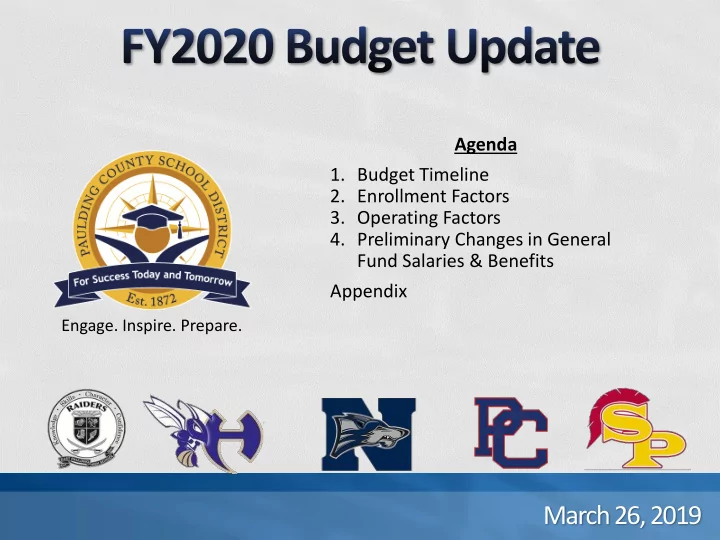

Agenda 1. Budget Timeline 2. Enrollment Factors 3. Operating Factors 4. Preliminary Changes in General Fund Salaries & Benefits Appendix Engage. Inspire. Prepare. March 26, 2019
Today March 26, 2019 Budget Outlook FY2020 Budget Approval Timeline 1 | Budget Timeline
Major Budget Influencers (MBI) must also be identified and considered within the framework, especially changes in funding and new or expanding influences on the budget, which may be positive or negative and short-term or long-term . Major Revenue Influencers Major Expenditure Influencers • • Enrollment Growth Enrollment Growth • • State Budget (Security Grant and Mental Health) ESEP • • QBE: State Teacher Scales (Local ✓ Enrollment (Weighted) Impact) ✓ Local Fair Share • Step Increases ✓ Teacher Pay Scale • TRS • • Equalization Grant: Custodial Services ✓ Rollback Impact ✓ Wealth per Weighted FTE • Changes in Local Sources: ✓ Property Taxes (MR) ✓ TAVT Major Budget Influencers 1 | Budget Timeline
Engage. Inspire. Prepare. Organization-wide Factors Influencing Decisions: Enrollment Factors
District Enrollment Growth 2 | Enrollment
Elementary School Growth: 13,283 Students an Increase of 168 or 1.3% Elementary School Projections 2 | Enrollment
Middle School Growth: 7,299 Students an Increase of 99 or 1.4% Middle School Projections 2 | Enrollment
High School Growth: 9,557 Students an Increase of 162 or 1.7% High School Projections 2 | Enrollment
Enrollment Growth. In the 8 years preceding the collapse of the housing market, the district experienced tremendous enrollment growth, increasing over 80% from fiscal years 2000 to 2007. From 2008 to 2011 enrollment growth declined by two-thirds. By 2012, enrollment was declining, compared to modest increases statewide. From 2013 to 2019 enrollment grew 1,600 or 5.7%. 2019 enrollment grew 1.7%, the largest growth rate in a decade and much more than the large district average of 0.2%. 2020 is projected to grow 429 or 1.4%. District Enrollment Growth 2 | Enrollment
ESEP Enrollment Growth. Enrollment in Exceptional Students Educational Programs (ESEP) have increased dramatically over the past several years. In FY2018, the average additional cost per ESEP student was $2,134 or $8.9 million total. • 65% increase over the past 8 years verses -1% in non-ESEP • 14% greater cost (local and state sources) • Approximately $327 per pupil or $1.4 million is funded locally • 22% greater cost (local, state and federal sources) Note: Total include Pre-K Enrollment Growth 2 | Enrollment
Engage. Inspire. Prepare. Organization-wide Factors Influencing Decisions: Operating Factors
Business Services, 11 , Central & Other Support, Maintenance & General 0% Administration, 12 , 0% Improvement of Pupil Services, 48 , 2% Allotments: Transportation, 293 , 9% +29 School-Based Media, 66 , 2% +30 ESEP School Administration, 205 , 7% General Fund Positions Instruction 1,764 Special Education 592 School Administration 205 Instruction, 1,764 , Media 66 56% Transportation 293 Pupil Services 48 72% Improvement of Instruction 79 Special Education, Instruction Maintenance & Construction 53 592 , 19% Central & Other Support 23 2,251 Business Services 11 General Administration 12 Total General Fund Positions 3,147 FY2020 Preliminary GF Allotments 3 | GF Allotments
100% 90% T&E Certification 80% 70% 60% • 31% Bachelor 50% 40% 30% • 37% Masters 20% 10% 0% FY2014 FY2015 FY2016 FY2017 FY2018 FY2019 • 27% Specialist T7 (EdD) 2% 3% 3% 3% 3% 3% T6 (Specialist) 30% 30% 30% 28% 29% 27% T5 (Master) 41% 40% 37% 38% 36% 37% • 67% Advanced T4 (Bachelor) 25% 26% 29% 30% 30% 31% Provisional Certification 1% 2% 1% 1% 2% 2% 80% T&E Experience 70% 60% 50% • 27% 0-8 Years 40% 30% 20% • 24% 9-14 Years 10% 0% FY2014 FY2015 FY2016 FY2017 FY2018 FY2019 • 25% 15-20 Years 0-8 Years 24% 23% 25% 25% 27% 27% 9-14 Years 33% 33% 30% 29% 27% 24% 15-20 Years 24% 25% 26% 25% 24% 25% • 24% +21 Years 21+ Years 19% 20% 19% 21% 23% 24% >8 Years 76% 77% 75% 75% 73% 73% Based on October 2018 CPI Count Certification & Experience (QBE) 3 | Operating Factor
TRS Employer Contribution Rates 25.00% 21.14% 20.90% 20.00% 16.81% 14.27% 14.27% 15.00% 13.15% 12.28% 11.41% 10.28% 10.00% 5.00% 0.00% FY2012 FY2013 FY2014 FY2015 FY2016 FY2017 FY2018 FY2019 FY2020 TRS Contribution. Since FY2012, the Teacher Retirement System (TRS) contribution rate has increased 106%. The TRS budget for FY2019 is $32.6 million or approximately 12% of the total General Fund budget. These expenditures are funded with state and local resources. TRS Contributions 3 | Operating Factor
FY2020 Preliminary GF Allotments 5 | Preliminary Changes
FY2020 Preliminary GF Allotments 5 | Preliminary Changes
Coming up: April 23, 2019 Revenue Projections FY2020 Budget Approval Timeline 1 | Budget Timeline
Engage. Inspire. Prepare. Thank You For Budget Ideas and Feedback: Visit our Website (Budget Ideas) or Email Budget@Paulding.k12.ga.us
Recommend
More recommend